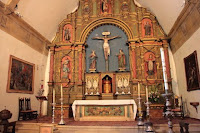
Continuing on our tour of the Monterey Peninsula area, we spent some time in the famous town of Carmel-by-the-Sea, situated at the south end of the 17-Mile Drive. As with the entire region, Carmel is noted for its scenic beauty, as well as being the home of many famous writers, poets, artists, and movie celebrities. Carmel is a wonderful town to walk, with many high-end shops, restaurants, and art galleries. While in Carmel, we paid a visit to the Mission San Carlos Borromeo de Carmelo, also known as the Carmel Mission. The mission was first established in 1770 and was destroyed by fire in the mid-1800’s. The current buildings were restored starting in 1884. Carmel Mission is considered one of the most beautiful missions in the chain of nine missions that stretches along California’s Central Coast.


I’ve been to the Monterey area a number of times in the past, but never took the opportunity to drive south along the scenic coastline of Big Sur. On this trip, we decided not to miss out on the chance to see the stunning views.

We didn’t make the entire drive from Carmel to the south end of Big Sur, but went as far south on California Highway 1 as the Nepenthe Restaurant. The highway winds along the western edge of the Santa Lucia mountain range mostly within sight of the Pacific Ocean, varying from near sea level up to a thousand-foot sheer drop to the water, providing some of the most spectacular views in the world. On the way back we also decided to take a side trip into Pfeiffer Big Sur State Park to look around the Big Sur Lodge and take a hike out to Pfeiffer Falls.

Big Sur Beach (Click on photo for info)

Though technically not in Monterey, I wanted to include one of the most picturesque and photographed lighthouses on the Pacific coast. Located on the scenic coastal highway (California Route 1), midway between Santa Cruz and Half Moon Bay, Pigeon Point Lighthouse is the tallest lighthouse on the west coast of the US. We stopped to take pictures on our way to San Francisco from Monterey. Unfortunately, the tower has been closed to tours since 2001 because of collapse of brickwork supporting outside access walkways on the top of the structure, but the restored lighthouse keepers housing serves as a hostel for travelers. The four three-bedroom houses next to the lighthouse have overnight lodging for up to 50 people of all ages.

Pigeon Point Lighthouse (Click on photo for info)
If you have a chance, please check out my ImageKind Galleries and Flickr Collections

















